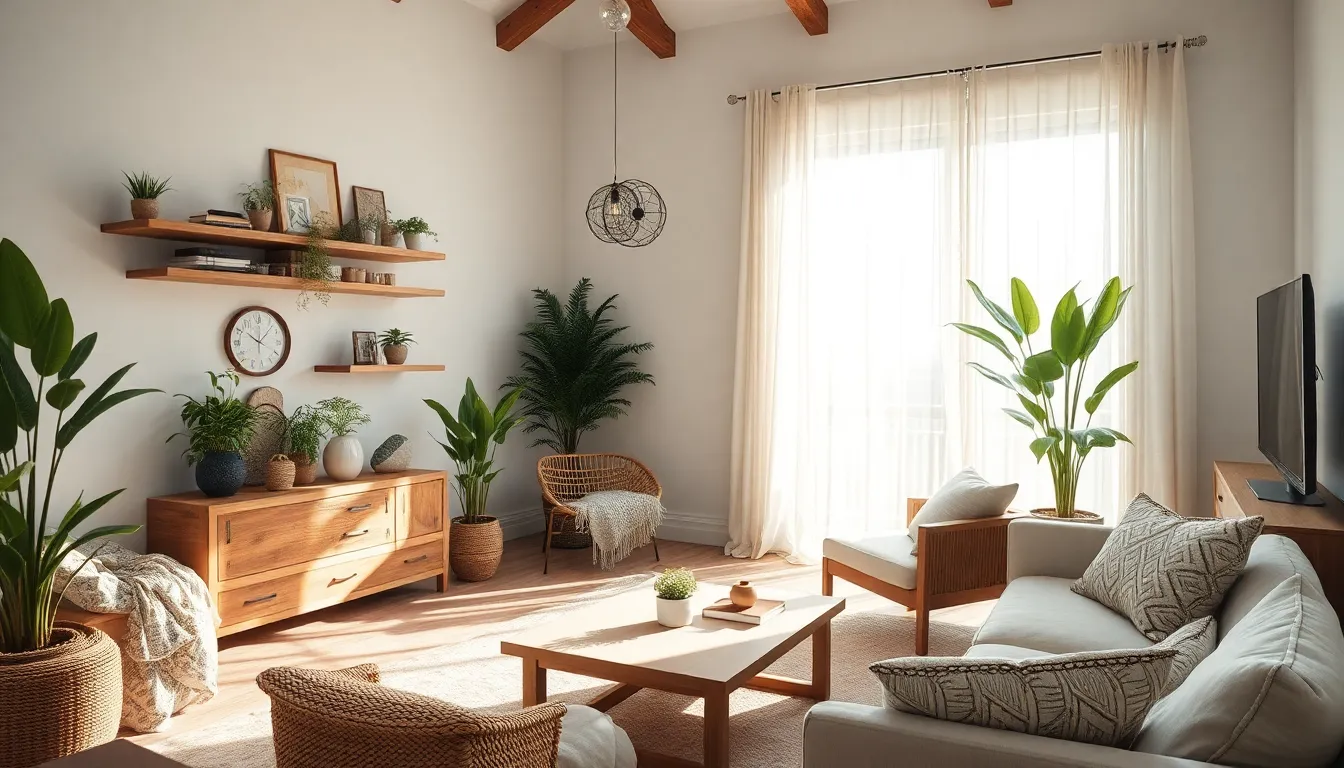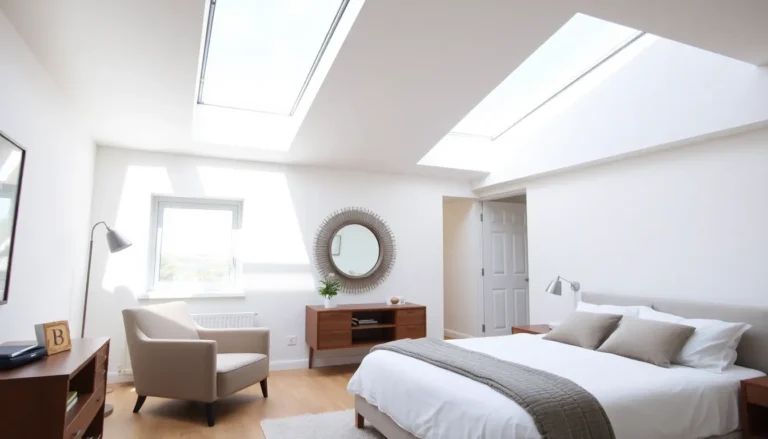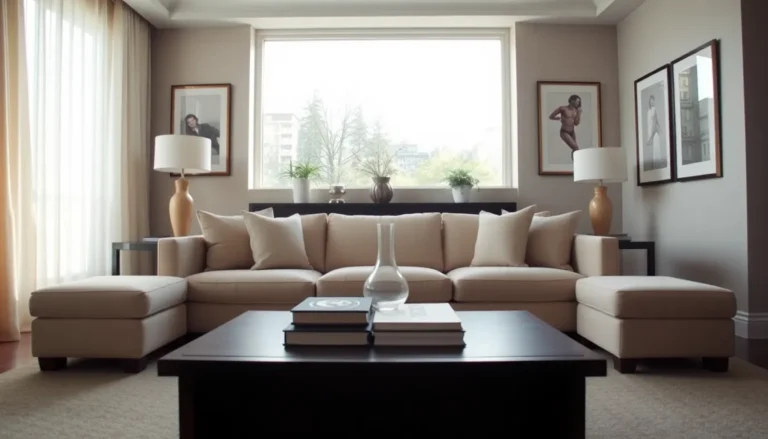In a world where plastic seems to be the reigning champion of home decor, eco-friendly decor is like that quirky friend who shows up with a plant instead of a bottle of wine. It’s fresh, stylish, and just a tad rebellious. Who knew saving the planet could look so good?
Table of Contents
ToggleWhat Is Eco-Friendly Decor?
Eco-friendly decor encompasses sustainable, stylish home furnishing and decoration choices that promote environmental health. This approach emphasizes materials and designs minimizing harm to the planet.
Definition and Importance
Eco-friendly decor refers to home design centered on sustainability and resource conservation. It prioritizes materials sourced from renewable resources and processes that reduce carbon footprints. Choosing eco-friendly decor lowers environmental impact while enhancing aesthetics. This movement plays a significant role in promoting awareness about sustainability and encouraging conscious consumerism.
Key Characteristics
Key characteristics define eco-friendly decor, emphasizing sustainability and style. Materials like bamboo, reclaimed wood, and organic fabrics exemplify eco-friendly options. Designs often feature energy-efficient lighting and low-VOC paints that enhance indoor air quality. Another characteristic involves sourcing products from local artisans, reducing transportation emissions. Lastly, versatility plays a role; eco-friendly decor adapts to various styles, from modern minimalist to bohemian chic.
Benefits of Eco-Friendly Decor

Eco-friendly decor offers multiple advantages, positively influencing both individuals and the planet. Each benefit contributes to a healthier lifestyle and a sustainable future.
Environmental Impact
Eco-friendly decor significantly reduces environmental harm. Sustainable materials, like bamboo and reclaimed wood, require fewer resources to produce. By choosing such options, consumers lower their carbon footprints. Products sourced from local artisans cut down on transportation emissions. Energy-efficient lighting and low-VOC paints enhance energy conservation, preserving natural resources. Opting for these sustainable choices fosters a healthier planet while appealing to eco-conscious lifestyles.
Health Benefits
Health improvements accompany eco-friendly decor in various ways. Natural materials often lack harmful chemicals commonly found in conventional products. This reduction in toxins leads to better indoor air quality. Studies indicate that environments enriched with organic fabrics and non-toxic furnishings contribute to overall well-being. Moreover, sustainable decor promotes mental health; green elements, such as plants and earthy tones, create calming atmospheres. Prioritizing health through decor choices results in vibrant, restorative home environments.
Popular Eco-Friendly Decor Materials
Eco-friendly decor materials offer stylish and sustainable options for home furnishings. These materials not only enhance aesthetic appeal but also support environmental conservation.
Bamboo
Bamboo serves as a versatile and sustainable option in eco-friendly decor. It grows rapidly, reaching maturity in three to five years, making it a highly renewable resource. This natural material showcases durability and strength while remaining lightweight. Various products, from furniture to accessories, feature bamboo due to its sleek appearance. Its natural antibacterial properties improve indoor air quality, contributing to a healthier living space. Using bamboo aligns with principles of sustainability, promoting a connection with nature.
Recycled Materials
Recycled materials play a significant role in eco-friendly decor, reducing waste and minimizing the need for new resources. Items like reclaimed wood, recycled glass, and metal fixtures embody craftsmanship and individuality. The use of reclaimed wood in furniture brings history and character to any space. Recycled glass accents offer vibrant colors while being environmentally responsible. Each piece tells a unique story, enhancing personal and sustainable aesthetic values. Choosing decor made from recycled materials represents a practical commitment to sustainability, merging style and responsibility.
Organic Fabrics
Organic fabrics made from cotton, linen, and hemp prioritize health and sustainability. These textiles avoid harmful chemicals and pesticides, promoting safer indoor environments. Softness and breathability characterize organic cotton, making it ideal for upholstery and curtains. Linen, known for its durability, adds an elegant touch to home textiles. Hemp stands out for its strength and versatility, suitable for various decor items. Utilizing organic fabrics supports eco-conscious practices while enhancing comfort and style in living spaces. This choice reflects an awareness of individual well-being and environmental impact.
Tips for Incorporating Eco-Friendly Decor
Incorporating eco-friendly decor enhances aesthetics and promotes sustainability. These tips provide effective strategies to create an eco-conscious environment.
Interior Design Strategies
Choose natural materials to infuse warmth into spaces. Incorporating plants not only adds life but also improves air quality. Selecting furniture made from reclaimed wood introduces a unique character while minimizing waste. Opt for energy-efficient lighting to save resources and reduce electricity bills. Mixing textures and patterns from organic fabrics introduces depth and visual interest. Utilizing multi-functional furniture maximizes space while maintaining style. Finally, embracing minimalist designs emphasizes the importance of essential items, reducing clutter and environmental impact.
Sustainable Sourcing
Support local artisans to enhance community economies and lower carbon footprints. Prioritize certification for materials that meet sustainability standards, ensuring responsible sources. Explore vintage shops for one-of-a-kind decor that promotes reuse and reduces demand for new products. Look for manufacturers who practice ethical sourcing, reflecting commitment to environmental responsibility. Engage with businesses focused on upcycling, transforming discarded materials into beautiful new pieces. Emphasizing transparency in sourcing practices reinforces trust and sustainable consumerism. Shopping at eco-friendly stores not only benefits the environment but also encourages conscious purchasing decisions.
Embracing eco-friendly decor is more than just a trend; it’s a lifestyle choice that reflects a commitment to sustainability and well-being. By opting for materials that are kind to the planet and prioritizing local artisans, individuals can create beautiful spaces that resonate with their values.
The blend of style and environmental consciousness not only enhances home aesthetics but also contributes to healthier living environments. As more people recognize the benefits of sustainable decor, the movement continues to grow, inspiring creativity and innovation in home design.
Ultimately, eco-friendly decor isn’t just about making a statement; it’s about making a difference.





